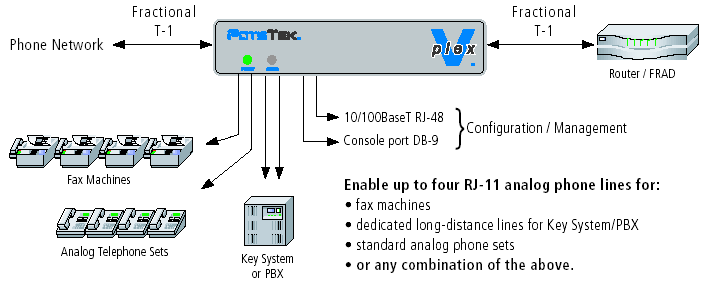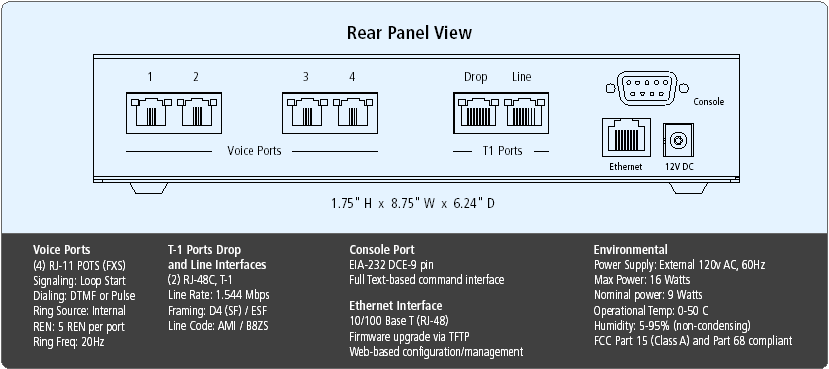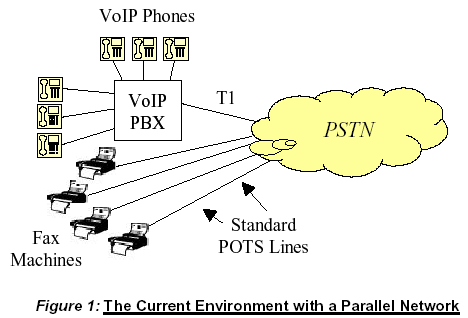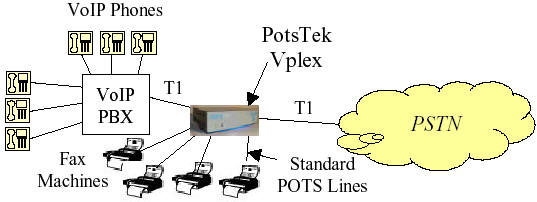|
Vplex
Voice Access Multiplexer |
The Vplex is a cost-effective,
customer-premise device that
integrates voice and data services over a single T-1 facility
 |
-
Reduces access costs of delivering voice and data services
to branch offices and small businesses
-
Delivers bundled voice and data services by optimizing use
of existing bandwidth
-
Fraction of the cost of a traditional Channel Bank or
Integrated Access Device
-
Utilizes existing data hardware infrastructure • Leverages
low cost, leased line access to long distance service
-
Reduces cost of additional voice grade business lines and
switched long distance charges
-
Allows mapping of any inbound channel to any port
-
Interfaces: (1) 10/100 Ethernet LAN, (2) RJ-48 T-1,
(4)* RJ-11 POTS, (1) DB-9 Console port
-
Allows for both local and remote configuration management
through menu-based console, HTTP, Telnet and SNMP
-
Visual Alarm Indicators for T-1 and Ethernet interfaces as
well as power and summary fault
-
Available in a four-port (four POTS ports) model
|
|
The
Vplex Voice Access Multiplexer
The Vplex
Voice Access Multiplexer lets you add the voice functionality of an
Integrated Access Device to a data network installation without replacing
existing data hardware.
The Vplex
is a cost-effective, customer-premise device that integrates voice and data
services over a single T-1 facility, allowing you to maintain your existing
data networking vendor and platforms. Connecting to the T-1 as it enters the
customer premises, the Vplex maps voice channels to its built-in RJ-11 voice
ports, then passes the remaining channels as a fractional T-1 to the
customer's data CSU/DSU, router, or other CPE gear. By utilizing a built-in
channel-switching matrix, each channel of the incoming T-1 can be groomed on
an "any-to-any" basis between the voice ports and the pass-through T-1
output, therefore allowing complete control of channel assignments and the
ultimate in flexibility.
As a fully
compliant, standards-based solution that is simple and easy to install,
Vplex is the answer to rapid deployment of new voice services. The Vplex
enables low cost integration of analog voice and data services over a common
T-1 line and helps service providers deliver new voice services, reduce
service delivery costs, optimize available bandwidth, and increase customer
retention with minimal incremental costs using existing customer hardware.
|
ypical Data Service installation with Vplex utilizing up to
four channels for analog calling.


Fax VoIP Bypass
Businesses are increasingly deploying Voice over IP (VoIP) as
the standard enterprise voice solution. VoIP enables businesses to consolidate
their voice service over a common data infrastructure, streamline administrative
staff, and reduce communications costs. The leading PBX manufacturers such as
Avaya, Nortel, Cisco, Siemens, and Alcatel are all investing heavily in
developing VoIP equipment.
At the same time, a well-worn legacy technology known as "fax",
with roots to 19th century telegraphy, refuses to go away. Fax remains the
standard "quick and dirty" tool for exchanging business and personal
information, especially between parties that do not frequently work together.
Healthcare, legal, government, hospitality, finance, education, and real estate
are among the numerous verticals heavily reliant on fax technology for their
business operations. IDC states that approximately $110 billion was spent on fax
telecom services in 2002. Fax accounts for 40-50% of the telephone bill for many
organizations with overseas business units.
But what happens when Fax meets VoIP?
The emerging VoIP and still stalwart fax services have proven to
be poor dancing partners. Fax is a real-time service optimized for the Public
Switched Telephone Network (PSTN). But over an IP packet network, fax quality is
compromised by lost packets, network delay, jitter, and out of sequence packets.
This results in terminated sessions, additional bandwidth requirements, and
reduced fax readability at the receiving end. In response, the industry has
developed the T.38 standard specifically for real-time fax transmission over an
IP infrastructure. This technique is known as Fax over IP (FoIP). It requires a
T.38 gateway at each end, retraining of office personnel on fax operation, and
connecting low-cost fax machines to $500+ T.38 gateways. Alternatively, the
enterprise can replace working fax machines with their more expensive T.38 FoIP
counterparts.
The business case for FoIP is further hampered because T.38
remains immature, with interoperability problems among the T.38 vendors (though
this inconvenience is being reduced over time). For these many reasons, FoIP is
not viewed as a viable alternative by the vast majority of fax users. The bottom
line is that FoIP is a headache that we can all do without. The T.38 option is
not practical given its limited adoption and uncertain future. The market
prefers traditional PSTN faxing by a wide margin, especially as long distance
PSTN costs continue to decline.
The current environment consists of parallel networks
Given the current environment, most enterprises running VoIP
adopt parallel networks similar to the one shown in Figure 1. There is a T1 line
connected from the VoIP PBX to the PSTN to support packet voice. This is
complemented with four parallel POTS lines to support the fax service. Even
small-medium sized enterprises, with as few as 50 employees, have multiple fax
machines so that they are physically close to the staff. Assuming that each POTS
business line costs $65 per month, this results in a charge of $260 per month
for the four lines. The enterprise pays $3,120 per year in this example, just
for fax access!

The VoIP and Fax Mousetrap -- Vplex
PotsTek has developed a better mousetrap with its Vplex
solution, illustrated in Figure 2, which integrates fax with VoIP, and
potentially other data services. The enterprise connects standard Group 3 fax
machines to the POTS lines supplied by the Vplex. Any of today’s common fax
machines are compatible, with pricing starting as low as $100, to over $1,000
for the more sophisticated units. The Vplex can be configured for one to four
fax lines, enabling the enterprise to locate each fax machine close to its
users.
The Vplex integrates the fax lines with the output of the VoIP
PBX, sending the combined services over a standard T1 line. The T1 is
channelized so that each individual fax and voice session is independently
routed to the destination. Configured with four analog active ports for fax,
over 1.2 Mbps remains available to IP traffic. Supporting fax services over the
Vplex T1 is superior to relying on individual business lines. T1 is a carrier
class service, complete with Service Level Agreement (SLAs), sophisticated
monitoring systems, and guaranteed mean-time-to-repair (MTR) metrics. A T1’s MTR
guarantee may vary between providers, but is typically about 4 hours whereas
individual business lines often have a 24-hour MTR. Additionally, T1 pricing
continues to erode in order to stay competitive with its lower quality DSL
colleague.

Enterprise Benefits
The Vplex provides the enterprise with three primary benefits.
First, it allows those businesses committed to VoIP to leverage all of its
digital advantages while continuing to secure standard reliable fax service.
There are no obstacles to exchanging faxes with the legions global fax users,
ranging from individual consumers to multi-billion dollar business partners
seeking a quick legal signature.
The second benefit is that all office equipment (phone, fax,
computer, printer) continues to perform as they always have. There is no
learning curve or additional distractions for the office staff. The third and
final benefit is cost savings. Enterprises may significantly reduce telephone
costs. In this example, the enterprise saves $3,120 annually by integrating the
fax service onto the T1, enabling it to cancel the four separate POTS lines
supporting fax services. Vplex users could end up achieving a positive ROI well
within six months.
Concluding Thoughts
VoIP is on its way while fax is here to stay. Vplex provides the
capability to support these trends. A sensible FoIP solution is not on the
horizon, in part because few organizations support the T.38 standard. PotsTek
has developed an elegant solution that cost effectively supports VoIP and
traditional fax over a single T1 line. Our solution is extremely practical,
empowering enterprises of all shapes and sizes to transition to VoIP, without
encountering excessive fax access charges or transmission aggravation.
ARC ELECTRONICS
301-924-7400 EXT 25
jump to ... Home Page
arc@arcelect.com




